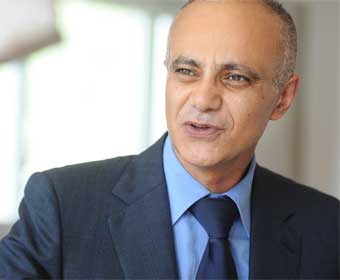On the LTE bus with Hossein Moiin, CTO, NSN
During the final day of my trip to Barcelona for MWC, I was treated to a bus ride. Not just any bus ride though. This was a bus loaded with tech kit, hooked up to a couple of prototype dongles and connected to the FDD and TDD flavours of LTE radio. The reason was a field demonstration of LTE’s capabilities, set up by Nokia Siemens Networks, Huawei, Vodafone and China Mobile.
February 28, 2011

During the final day of my trip to Barcelona for MWC, I was treated to a bus ride. Not just any bus ride, though. This was a bus loaded with tech kit, hooked up to a couple of prototype dongles and connected to the FDD and TDD flavours of LTE radio. The reason was a field demonstration of LTE’s capabilities, set up by Nokia Siemens Networks, Huawei, Vodafone and China Mobile.
The trial consisted of two cells, one provided by each of the vendors, with each cell divided into four sectors: two TDD and two FDD. The spectrum available, provided by Vodafone Spain, was 10MHz of 2.3GHz frequency for TDD and 2x10MHz of 2.6GHz frequency for FDD. The single mode dongles for the Huawei demo were both provided by Qualcomm while for the NSN demo, the FDD card was contributed by Samsung.
The drive test was focused on the end user experience and featured application usage based on different scenarios in order to show the basic performance of the system and demonstrate how operators can overcome the difficulties of sending rich media to customers.
We started off with a demonstration of 24 streams of video – each one showing different footage – mirrored across two widescreen displays, one connected via FDD and the other by TDD. The video was driving about 23Mbps of throughput, I was told, and Mark Atkinson global head of NSN’s TDD LTE business pointed out that at this point it’s the laptop that starts to become the bottleneck rather than the radio network. He also pointed out that HD video is currently the only user of high levels of bandwidth, as most apps can’t make use of the throughput available.
Hossein Moiin, NSN’s CTO, who I sat next to during the drive test, was impressed that there were no noticeable effects during the handover period from one cell to another. However, as he later conceded, this was nothing like a realistic network load.
Nevertheless, we also got to experience 20Mbps of streaming HD 3D video, as well as a live video feed taken from a camera on the bus, which was sent uplink over FDD and streamed back down over TDD, convincingly demonstrating a low latency of around 100ms at the cell edge, about 800m away from the cell site in rain and fog, which Moiin said made it all the more impressive given the poor radio weather conditions.
I got to experience the low latency first hand – playing one of the engineers on the bus at a co-operative shoot ‘em up style game at which I was on TDD and he was on FDD, hitting latency of around 15-20ms.
Video conferencing and IMS also got a look in during a three-way video call between the bus, a Vodafone site in Germany, and another in Barcelona, all backhauled by LTE-FDD at 2.6GHz.
But most impressive was that fact that the entire demo was set up by ten engineers in less than a week (including set up the software apps for the demo), and while the network was not perfectly optimised, it still cranked out throughput of 50Mbps+ on FDD and 30Mbps+ on TDD. Clearly, speed is of the essence.
The seventh annual LTE World Summit takes place in Amsterdam on 17th – 18th May.
Read more about:
DiscussionAbout the Author(s)
You May Also Like








.png?width=300&auto=webp&quality=80&disable=upscale)


_1.jpg?width=300&auto=webp&quality=80&disable=upscale)


.png?width=800&auto=webp&quality=80&disable=upscale)